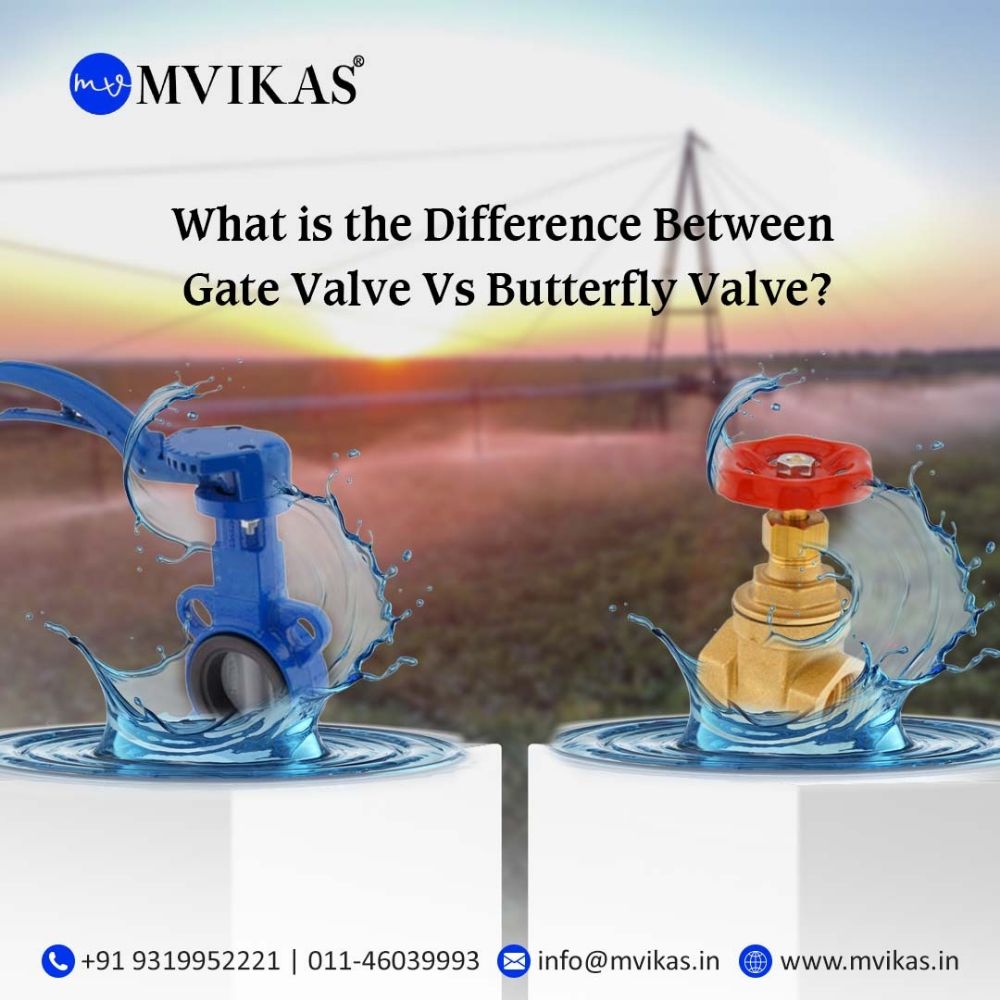Reachable at 9560662883  011-46039993 (Ext. 21 to 32) (10am - 06pm)
011-46039993 (Ext. 21 to 32) (10am - 06pm)
What is the Difference Between Gate Valve Vs Butterfly Valve?

A gate valve, also known as a sluice valve, opens by erecting a wall (gate) in the way of the fluid flow. When the gate is completely opened, gate valves barely hinder fluid flow and take up very little space along the pipe axis. The gate sides are typically wedge-shaped but might be parallel (to apply pressure on the sealing surface).
A butterfly valve is a type used to control or isolate fluid flow. A rotating disc acts as the closing mechanism. A shut-off valve with a comparatively straightforward design is a butterfly valve. While the disc is spun to enable flow in the open position, the closed position blocks the valve hole. The butterfly valve allows rapid opening and closing since it only requires a quarter turn from entirely open to fully closed position, or the reverse.
Difference between Gate Valve and Butterfly Valve
- Working Mechanism
Gate Valve
A movable door or gate is opened and closed by a gate valve. An operator operates this gate with mechanical assistance—typically a threaded screw. Gate valves have two states—completely open and closed—and the fully open state has reduced flow resistance. Since the gate is entirely out of the way when the valve is fully open, this allows the medium to flow freely. Gate valves frequently act as flow restrictors and change the medium's speed instead of the flow rate.
The gate valve's slow closing and opening rates are also a result of its high opening height.
Butterfly Valve
Butterfly valves are fraction valves that regulate the flow of the medium using a rotating disc. A stem supports the disc in the centre of the valve's body. Compared to gate valves, butterfly valves may be opened or closed in the tunnel by turning the operator a mere 90 degrees. A butterfly valve is typically opened or closed by an actuator that spins the valve's disc parallel to or perpendicular to the flow.
The disc is parallel to the flow unless the valve is fully open, at which point it is perpendicular.
- Maintenance
Gate Valve
It is perfect for this kind of upkeep. It is ideal for systems that employ pigging and swabbing for cleaning reasons.
Butterfly Valve
Although it’s tiny size and light weight make it relatively simple to maintain, repair, or install, its central disc prevents it from being ideal for systems that employ pigging and swabbing for cleaning reasons.
- Common Application
Gate Valve
Gate valves are widely used in pipelines that need tight sealing but don't require frequent switching since they have strong sealing properties. Since exact control is impossible, they can only be utilised in the fully open or fully closed states and cannot control or throttle the medium flow rate. The valve's seat and the gate will quickly deteriorate if it is maintained partly or halfway open. The pipeline will vibrate and generate noise due to the chattering wedge.
The gate valve's delayed opening and closing operations make it inappropriate for pipelines that require emergency shutoffs. Gate valves can withstand more considerable pressures along the pipe than butterfly valves. Gate valves are often used in large pipe systems that need continuous bi-directional liquid and gas flows and time-based uni-directional media discharges.
Butterfly Valve
In instances requiring wide pipe widths, butterfly valves are more convenient to use and install since they are lighter than gate valves. Wafer butterfly valves are advised in places where they are installed because they work best. In practice, butterfly valves are used more commonly in big sizes compared to gate valves. It is ideal for applications that need fast opening and shutting, particularly emergency shutoffs, since they may be operated often and open and close quickly. They are used for truncation and change or throttle flow rates. The optimum option for pipelines conveying tiny pollutants is a butterfly valve.
Butterfly valves are also called high-performance valves since they function in moderate to high temperatures and pressure settings.
- Price
Gate Valve
Gate valves may cost less than butterfly valves in lesser sizes, but as the calibre diameter grows, so does their price. Gate valves are inexpensive. In the open state, gate valves offer little media flow resistance and negligible pressure loss across the valve.
Butterfly Valve
Butterfly valves cost less than gate valves under normal circumstances for the same specs, diameter, and material. Therefore, butterfly valves are still less expensive at bigger sizes, which increases their use across a broader range of sectors.
- Better
Gate Valve
A gate valve is better suited for high-pressure applications since it has a more robust seal.
Butterfly Valve
A butterfly valve may be found in huge sizes and is less costly.
CONCLUSION
Depending on the installation's application needs, gate and butterfly valves have advantages and disadvantages. Gate valves are often the best choice for applications requiring rigorous sealing and infrequent operation, especially where an obstruction-free flow is sought. Large butterfly valves, however, would be great if you need a valve for throttling reasons that take up less room for large systems. Most applications use Butterfly Valves more frequently than other types of valves.




Leave your comment